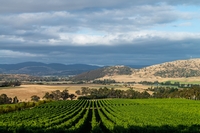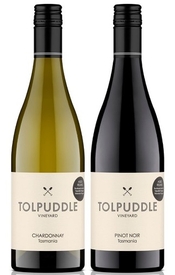I sometimes have the morbid thought that today’s winery owners and winemakers all wish, upon their final departure to that great vendange in the sky, to have their tombstones etched with the words:
“The Wines of the Deceased Bore a Strong Sense of Place.”
But, at the same time, the producers wouldn’t mind if their Passports to Heaven were also stamped: “Yet their wines also bore a strong resemblance to those of the classic region” – whether that region is Bordeaux, Napa Valley, Burgundy, Champagne or somewhere else.
While adjectives have their place, we can’t get by without comparisons when we write or talk about most anything. Everyone and everything looks like, smells like, tastes like, sounds like, performs like something with which we are familiar, a cited standard that will draw an image or impression from our memory bank. Certainly,  we constantly do that with wines. “This wine strongly resembles Chablis, while that one reminds me of an Entre-Deux-Mers Blanc.”
we constantly do that with wines. “This wine strongly resembles Chablis, while that one reminds me of an Entre-Deux-Mers Blanc.”
Recently, in New York I was talking with Michael Hill Smith just after a tasting of his Tolpuddle Pinot Noirs and Chardonnays made on the island Tasmania off the southern coast of mainland Australia. The estate is owned by Hill and his cousin, Martin Shaw, who also jointly own Shaw + Smith wines in the Adelaide Hills. However, Tolpuddle has been their pet project since they purchased the 13-year-old vineyard in 2011, excited by its promise of being capable of growing very cool weather grapes that could produce elegant wines.
“Martin and I are quite different,” Hill remarks. “It wouldn’t be quite fair to say that Martin has done nothing spontaneously in his life.” So, the more-spontaneous Hill was surprised at how quickly the two decided to buy Tolpuddle while on a short jaunt to Tasmania with plans only to kick a few tires. Put in restaurant terms, Shaw the winemaker commands the kitchen while Hill the marketer handles the front of the house.
Tolpuddle was named in honor of English farm workers forcibly transported to the Australian mainland and to  Tasmania in 1834 as prisoners for having the audacity to form a labor movement in their native town of Tolpuddle near the English Channel. The vineyard’s original 20 hectares were planted half and half to Chardonnay and Pinot Noir, mainly with clones suitable for making sparkling wines. “Tolpuddle is Champagne cold, colder than Burgundy,” Smith says, “but with more sun.” The first vintage was 2012.
Tasmania in 1834 as prisoners for having the audacity to form a labor movement in their native town of Tolpuddle near the English Channel. The vineyard’s original 20 hectares were planted half and half to Chardonnay and Pinot Noir, mainly with clones suitable for making sparkling wines. “Tolpuddle is Champagne cold, colder than Burgundy,” Smith says, “but with more sun.” The first vintage was 2012.
In the time since, Smith and Shaw have worked to plant clones more suitable for table wines, rather than for sparkling base wines, and changed spur training to cane pruning among other improvements.
The Tolpuddle wines – we tasted the 2015, 2017, 2020 and 2021 vintages each of Chardonnay and Pinot Noir – are quite well made and very enjoyable, especially for their prices (just under $80), and fall comfortably in the 90 to 95 points ratings range. But what do they taste like? “The wines all seem like they have one foot in Burgundy and one in Tolpuddle,” I mused to Smith in our conversation, and I was a bit surprised when he quickly agreed that was fair comment. After all, Burgundy got there first in establishing a standard by which cool-weather Chardonnays and Pinot Noirs are usually compared.
 My own opinion is that great cool-weather Chards and Pinots, such as those of Tolpuddle, at their best share Burgundy’s lean and linear acidic backbone, its stony and sometimes chalky minerality and sometimes a savory note or two. And, as Shaw had earlier mentioned, “At first, we didn’t realize the acidity of Tasmania. I thought the first vintage tasted like battery acid, although it got better.” Even after 100% malolactic, the wines still have an edge to them, though a pleasant one. “The winemaker [Adam Wadewitz] also likes to be on the edge of reduction,” Smith says, “and building phenolics to add texture is a relatively new thing in Australia.”
My own opinion is that great cool-weather Chards and Pinots, such as those of Tolpuddle, at their best share Burgundy’s lean and linear acidic backbone, its stony and sometimes chalky minerality and sometimes a savory note or two. And, as Shaw had earlier mentioned, “At first, we didn’t realize the acidity of Tasmania. I thought the first vintage tasted like battery acid, although it got better.” Even after 100% malolactic, the wines still have an edge to them, though a pleasant one. “The winemaker [Adam Wadewitz] also likes to be on the edge of reduction,” Smith says, “and building phenolics to add texture is a relatively new thing in Australia.”
It is Burgundy’s haunting complexity of fruit and perfume, however, which often seems to elude most Chardonnays and Pinot Noirs that come from anywhere else. The fruitiness expressed in both the Tolpuddle Chardonnays and Pinot Noirs is somewhat different from those of Burgundies – the “other foot” that may be attributable to the terroir of the Coal River region where Tolpuddle is located. Some of the taste differences, especially between older and younger vintages, may also be attributable to gradual changes made in clones and vineyard management.
For example, the two early vintages of Chardonnays had a touch of “grapey-ness” much like I experienced in Chardonnays made on America’s East Coast in the 1980s and 1990s along with some red grapefruit, while the latter two vintages had more of the traditional Burgundian crisp-apple flavors and perhaps more minerality. The later-vintage Pinots seemed to have more bright, red fruit than the earlier ones, which I preferred. And while the cherry flavors were spot-on typical Pinot, there were few rooty or cola flavors of great Pinots, and hence were less complex.
68
